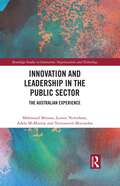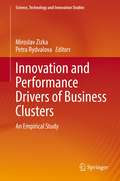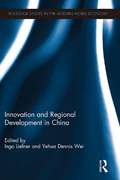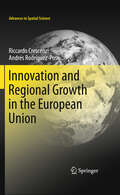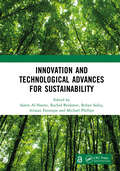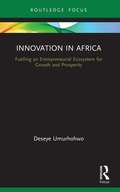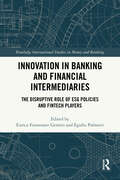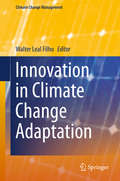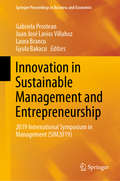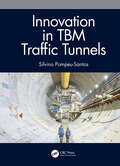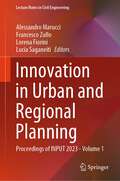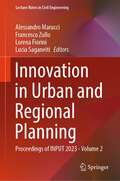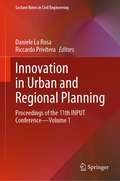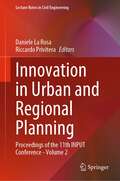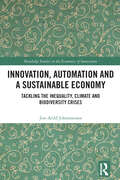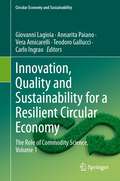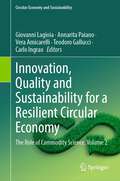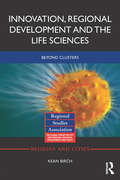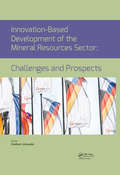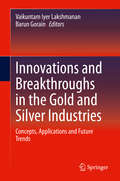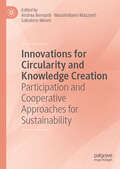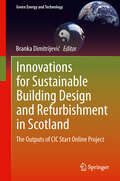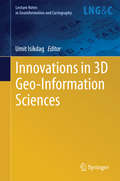- Table View
- List View
Innovation and Leadership in the Public Sector: The Australian Experience (Routledge Studies in Innovation, Organizations and Technology)
by Nuttawuth Muenjohn Adela McMurray Mahmoud Moussa Leonie NewnhamUsing empirical data, this book uniquely presents the dynamics of innovation within public sector organisations and identifies the most crucial factors that promote innovation or the determinants that enhance innovation activities. It presents a macro and micro analysis of workplace innovation in the Australian public sector written by a combination of practitioners and academics to provide both theoretical and practical insights. The book reviews the relationship between culture and workplace innovation as a multi-dimensional, subjective and context specific phenomenon operating dynamically as organisational innovation, organisational climate for innovation, team and individual innovation. It identifies a variance in the perception of workplace innovation and organisational culture between public sector employees with different demographic and employment characteristics. The demographic and employment characteristics confirm that employees in a Public Sector Department of State exhibit significant differences between various groups in how culture impacts on workplace innovation. This knowledge assists practitioners in developing positive cultural environments that support the development of workplace innovation and raise awareness in considering the differences within organisations caused by an individual’s characteristics. Lastly, the book reviews public organisations around the world and provides a cross cultural comparison of public sector innovation and leadership. This includes a review of the major forms of public sector systems in operation and how this relates to innovation and leadership. Innovation and Leadership in the Public Sector is written for academics and students interested in the public sector innovation field. It’s suitable for both graduate and undergraduate students and researchers in the fields of public administration, management policy, organisational behaviour, human resources management (HRM) and human resources development (HRD) courses. Additionally, this book is suitable for middle-to-senior-level administrators or managers who wish to develop more innovative public sector organisations.
Innovation and Leadership in the Public Sector: The Australian Experience (Routledge Studies in Innovation, Organizations and Technology)
by Nuttawuth Muenjohn Adela McMurray Mahmoud Moussa Leonie NewnhamUsing empirical data, this book uniquely presents the dynamics of innovation within public sector organisations and identifies the most crucial factors that promote innovation or the determinants that enhance innovation activities. It presents a macro and micro analysis of workplace innovation in the Australian public sector written by a combination of practitioners and academics to provide both theoretical and practical insights.The book reviews the relationship between culture and workplace innovation as a multi-dimensional, subjective and context-specific phenomenon operating dynamically as organisational innovation, organisational climate for innovation, team and individual innovation. It identifies a variance in the perception of workplace innovation and organisational culture between public sector employees with different demographic and employment characteristics. The demographic and employment characteristics confirm that employees in a Public Sector Department of State exhibit significant differences between various groups in how culture impacts on workplace innovation. This knowledge assists practitioners in developing positive cultural environments that support the development of workplace innovation and raise awareness in considering the differences within organisations caused by an individual’s characteristics. Lastly, the book reviews public organisations around the world and provides a cross cultural comparison of public sector innovation and leadership. This includes a review of the major forms of public sector systems in operation and how this relates to innovation and leadership.Innovation and Leadership in the Public Sector is written for academics and students interested in the public sector innovation field. It’s suitable for both graduate and undergraduate students and researchers in the fields of public administration, management policy, organisational behaviour, human resources management (HRM) and human resources development (HRD) courses. Additionally, this book is suitable for middle-to-senior-level administrators or managers who wish to develop more innovative public sector organisations.
Innovation and Performance Drivers of Business Clusters: An Empirical Study (Science, Technology and Innovation Studies)
by Miroslav Zizka Petra RydvalovaThis book highlights the importance of clusters for the competitiveness of companies and is divided into three interrelated parts. The first part focuses on localization economics, cluster theory, the role of innovation, and innovation partnerships in cluster formations. The second part of the volume presents original research carried out from 2018 to 2020 in the field of both natural clusters and organized clusters. In addition to examining the impact of cluster membership, the contributions also focus on additional factors that may affect the financial performance of companies. In the third part, an additional survey and case studies are presented, to examine the specifics of family businesses in selected industrial districts of the textile, glass, and jewelry industries. A broader overview of the development of dominant industries in the selected districts is provided, for an easier understanding of the relationships of competition among companies and locations in the business clusters. The book evaluates implications for microeconomic and macroeconomic policies and provides proposals for corporate inter-organizational behavior.This volume addresses scholars and researchers of economics, business, and management, as well as policy-makers and practitioners interested in a better understanding of innovation and performance drivers of business clusters.
Innovation and Regional Development in China (Routledge Studies in the Modern World Economy #120)
by Ingo Liefner Yehua Dennis WeiAlthough China is now the ‘factory of the world’, there is no reason to expect that it will always be content with manufacturing labor-intensive goods for foreign corporations. Scholars must now ask: What is the current level of innovation in China? And how can we face this challenge and renovate industrial production and innovation capacities in developed countries? This edited volume investigates the unique characteristics of Chinese innovation and regional development, China’s policy framework, and the role that transnational corporations play in China’s increasing innovation activities. This book contributes to the heated debate regarding pathways for technology progress and regional development in developing countries, and identifies the ways in which local production networks respond to different configurations of external linkages. Linking patterns of global and local production networks with the trajectories of technology development and regional development allows the authors to theorize and test whether, and how, particular configurations of production networks generate divergent long-term local productivity growth and technological development outcomes. Innovation and Regional Development in China will be of interest to geographers, economists, China specialists, development specialists, and scholars working on innovation and regional development in developing areas and transition countries.
Innovation and Regional Growth in the European Union
by Andrés Rodríguez-Pose Riccardo CrescenziThis book investigates the EU's regional growth dynamics and, in particular, the reasons why peripheral and socio-economically disadvantaged areas have persistently failed to catch up with the rest of the Union. It shows that the capability of the knowledge-based growth model to deliver its expected benefits to these areas crucially depends on tackling a specific set of socio-institutional factors which prevents innovation from being effectively translated into economic growth. The book takes an eclectic approach to the territorial genesis of innovation and regional growth by combining different theoretical strands into one model of empirical analysis covering the whole EU-25. An in-depth comparative analysis with the United States is also included, providing significant insights into the distinctive features of the European process of innovation and its territorial determinants. The evidence produced in the book is extensively applied to the analysis of EU development policies.
Innovation and Technological Advances for Sustainability: Proceedings of the International Conference on Innovation and Technological Advances for Sustainability, (ITAS 2023), March 01-03, 2023, Doha, Qatar
by Michael Phillips Rachid Benlamri Rehan Sadiq Salem Al-Naemi Aitazaz FarooqueThe proceedings publication of the International Conference on Innovation and Technological Advances for Sustainability (ITAS 2023) captures the essence of a dynamic international forum dedicated to advancing the United Nations Sustainable Development Goals (UN-SDGs).This publication serves as a comprehensive repository of cutting-edge research, innovative strategies, and transformative tools discussed by a diverse community of participants, including researchers, academics, students, policymakers, industry leaders, and government officials. Encompassing local, regional, and international perspectives, the proceedings delve into critical global issues such as food security, environmental preservation, energy sustainability, economic resilience, and the role of digital technologies in fostering sustainable development.The publication distills the key messages of ITAS 2023, emphasizing the showcasing of national and international accomplishments, fostering global collaborations, exploring future challenges and opportunities, introducing state-of-the-art technologies, and providing policy recommendations for building a sustainable society. It acts as a bridge between research and practice, promoting the dissemination of knowledge that will contribute to the achievement of UN-SDGs.
Innovation in Africa: Fuelling an Entrepreneurial Ecosystem for Growth and Prosperity (Routledge Focus on Business and Management)
by Deseye UmurhohwoThis book emphasizes the need for promoting innovation on the African continent. It identifies the roadblocks for entrepreneurs and discusses ways for developing an ecosystem for innovators to pave a way through the barriers and create ground-breaking products and new technologies which meet consumers’ needs in Africa. In order to stimulate innovation in African countries, there is the need for a more appropriate approach for innovation to occur in a context of international openness to knowledge. This book adopts a practical approach, demonstrating how innovation is an important driver of economic growth and competitiveness. It shows that innovation in Africa should be driven by local people, in response to local problems, and that open technology and knowledge sharing are vital to this project. It further explores key enablers such as the discovery of innovative talent, overcoming barriers, building strategic partnerships and promoting innovation across the continent. The book places emphasis on the creation of an innovation ecosystem as a value-creating tool by stakeholders for nation building and growth in Africa. This book will be of interest to researchers, students, international agencies, governments, businesses and individuals interested in the field of innovation and its potentials. It will also be relevant to investors, manufacturers and other stakeholders involved in the economic development of Africa.
Innovation in Banking and Financial Intermediaries: The Disruptive Role of ESG Policies and Fintech Players (Routledge International Studies in Money and Banking)
by Egidio Palmieri Enrico Fioravante GerettoThis volume provides a thorough examination of the drivers of recent innovations in the financial sector. The book's distinctive feature lies in its unique integration of two subjects of particular relevance in the fields of finance and banking: Environmental, Social and Governance (ESG) policies and Fintech innovations. This integration provides a comprehensive perspective on their interdependent influence and implications for financial intermediaries and the financial sector.The book offers an analysis of the theoretical and empirical essentials behind these transformations, including empirical analyses of the bank-specific impact of ESG factors on ratings, loan quality and internal control systems. While facilitating broader research regarding sustainable finance and providing essential findings for those hoping to comprehend and implement the aforementioned strategies into practice, the volume showcases the increasing significance of environmental issues in financial decision-making. Finally, the book addresses the way financial technology innovations are causing disruption to so-called "traditional" credit markets and affecting banking stability in general. It offers a comparison of green and brown Fintech, examining their safety and sustainability dimensions, and discuss the trade-off between progress and the need for responsibility.This work serves to bridge a significant gap between theoretical and practical approaches, providing findings and implications for researchers and academics studying finance, technology and sustainability. Through multiple methodologies, the authors explore changes related to ESG and Fintech, facilitating deeper understanding of their operational implications and significance.
Innovation in Climate Change Adaptation
by Walter Leal FilhoThis book introduces innovative approaches to pursue climate change adaptation and to support the long-term implementation of climate change policies. Offering new case studies and data, as well as projects and initiatives implemented across the globe, the contributors present new tools, approaches and methods to pursue and facilitate innovation in climate change adaptation.
Innovation in Food Ecosystems: Entrepreneurship for a Sustainable Future (Contributions to Management Science)
by Paola De Bernardi Danny AzucarThis book addresses the intersections of entrepreneurship, innovation and sustainability in food systems, and presents high-quality research illustrating the central role that food consumption and production play in achieving sustainability goals.Entrepreneurship and innovation have become particularly relevant aspects in the European Union (EU), especially since the Sustainable Development Goals (SDGs) were announced in 2015. In many cases, innovations tend to arise from small and medium-sized enterprises, and from completely new entrepreneurial endeavors. This book represents essential reading for researchers and young academics seeking to reduce disparities and inequalities in food production and consumptions patterns. By encouraging sustainable entrepreneurship and innovation, it will also help young scholars find support for their startup ideas.
Innovation in Sustainable Management and Entrepreneurship: 2019 International Symposium in Management (SIM2019) (Springer Proceedings in Business and Economics)
by Gabriela Prostean Juan José Lavios Villahoz Laura Brancu Gyula BakacsiThis book analyses state-of-the-art techniques in business process management as drivers of advanced entrepreneurship, financial management, supply chain management, and sustainability management. The role of management in a rapidly-changing environment and the use of innovative methods and techniques to address and solve key management problems are also explored.
Innovation in TBM Traffic Tunnels
by Silvino Pompeu-SantosTunnel Boring Machine (TBM) constructed tunnels are widespread, and can deliver significant environmental and cost benefits. However, as noted in the noteworthy examples of TBM traffic tunnels presented in this book, there are still important challenges associated with them, linked in particular to structural safety in the event of earthquakes, as well as cost and safety issues during operation. To face these challenges, Innovation in TBM Traffic Tunnels presents three innovative concepts in the field of construction of TBM rail and road tunnels: the TISB concept that improves the structural safety of those built on soft soil in seismic areas, and the TMG and TMF concepts, for rail and road tunnels, respectively, that allow for significant reduction of their cost and the improvement of safety during operation. Examples of the application of these new concepts in the conceptual design of specific tunnel cases are presented and compared with solutions based on common approaches, demonstrating the additional benefits of these concepts. The book also draws attention to other innovations in TBM tunnelling that may improve the construction of tunnels in the future, especially when using the concepts mentioned above. Innovation in TBM Traffic Tunnels is aimed at professionals involved in the planning, design, and construction of tunnels for transport infrastructure, including authorities, consultants and construction companies, worldwide.
Innovation in Urban and Regional Planning: Proceedings of INPUT 2023 - Volume 1 (Lecture Notes in Civil Engineering #467)
by Alessandro Marucci Francesco Zullo Lorena Fiorini Lucia SaganeitiThis book gathers the proceedings of the INPUT2023 Conference on ‘Innovation in Urban and Regional Planning.’ The 12th International Conference INPUT was held at the University of L'Aquila, Italy, on September 6–8, 2023, and brought together international scholars in the fields of planning, civil engineering and architecture, ecology, and social science, to strengthen the knowledge on nature-based solutions and to enhance the implementation and replication of these solutions in different contexts. The book represents the state of the art of modeling and computational approaches to innovations in urban and regional planning, with a transdisciplinary and borderless character to address the complexity of contemporary socio-ecological systems and following a practice-oriented and problem-solving approach. Computational tools, technologies, data, mathematical models, and decision support tools are explored for providing innovative spatial planning modeling methodologies.
Innovation in Urban and Regional Planning: Proceedings of INPUT 2023 - Volume 2 (Lecture Notes in Civil Engineering #463)
by Alessandro Marucci Francesco Zullo Lorena Fiorini Lucia SaganeitiThis book gathers the proceedings of the INPUT2023 Conference on ‘Innovation in Urban and Regional Planning.’ The 12th International Conference INPUT was held at the University of L'Aquila, Italy, on September 6–8, 2023, and brought together international scholars in the fields of planning, civil engineering and architecture, ecology, and social science, to strengthen the knowledge on nature-based solutions and to enhance the implementation and replication of these solutions in different contexts. The book represents the state of the art of modeling and computational approaches to innovations in urban and regional planning, with a transdisciplinary and borderless character to address the complexity of contemporary socio-ecological systems and following a practice-oriented and problem-solving approach. Computational tools, technologies, data, mathematical models, and decision support tools are explored for providing innovative spatial planningmodeling methodologies.
Innovation in Urban and Regional Planning: Proceedings of the 11th INPUT Conference - Volume 1 (Lecture Notes in Civil Engineering #146)
by Daniele La Rosa Riccardo PriviteraThis book gathers the latest advances, innovations, and applications in urban and regional planning processes and science, as presented by international researchers at the 11th International Conference on Innovation in Urban and Regional Planning (INPUT), held in Catania, Italy, on September 8-10, 2021. The overarching theme of the conference INPUT 2021 was “Integrating Nature-Based Solutions in Planning Science and Practice”, with contributes focusing on functionality of urban ecosystems toward more healthier and resilient cities, planning solutions for socio-ecological systems, technologies and hybrid models for spatial planning, geodesign, urban metabolism, computational planning, ecosystems services, green infrastructure, climate change adaptation and mitigation, rural landscapes, cultural heritage, and accessibility for urban planning. The conference brought together international scholars in the field of planning, civil engineering and architecture, ecology and social science, to build and consolidate the knowledge and evidence on NBS in urban and regional planning.
Innovation in Urban and Regional Planning: Proceedings of the 11th INPUT Conference - Volume 2 (Lecture Notes in Civil Engineering #242)
by Daniele La Rosa Riccardo PriviteraThis book is the second Volume of the INPUT2020 Conference Proceedings on ‘Innovation in Urban and Regional Planning’. The 11th International Conference INPUT was held at the University of Catania (Italy) on September 8-10th 2021 and allowed gathering international scholars in the fields of planning, civil engineering and architecture, ecology and social science, to strengthen the knowledge on nature-based solutions and to enhance the implementation and replication of these solutions in different contexts. INPUT2020 Conference stressed the basic idea that using components that mimic natural processes in the built environment can generate a wide number of benefits in cities, and produced more equal, safe and livable urban environment. The book provides additional reflections and proposals on empirical frameworks for nature-based solutions. Computational tools, technologies, data and hybrid models are explored for providing innovative spatial planning modeling methodologies. Furthermore, prospective roles of nature-based solutions in planning science and practice are investigated in the light of peripheralisation risks, rural landscapes and innovation in cultural heritage.
Innovation, Automation and a Sustainable Economy: Tackling the Inequality, Climate and Biodiversity Crises (Routledge Studies in the Economics of Innovation)
by Jon-Arild JohannessenEconomic inequality, the environmental crisis and the climate crisis are systemically linked. Accordingly, they should be understood as a single, interconnected system and strategies for resolving them should be guided by this understanding. This book demonstrates how the Green New Deal and its systemic alternative, the Red New Deal, could influence the course of these three global crises, all within the context of the Fourth Industrial Revolution.The author has developed several scenarios that are relevant to the automation that will result from advances in artificial intelligence and intelligent robots. The first is one of mass unemployment, while the second envisages low rates of unemployment, although workers will experience stagnation and then a decline in their wages. It is possible to envisage a different set of scenarios; however, we must replace the capitalist economic model with a different model: mutualism, a sustainable model that would allow for economic growth while also addressing the three current systemic crises. The author argues that if such a model is implemented, there will be jobs for everyone and the climate crisis will be tackled because people’s welfare will be prioritized over profit. We can assert that such a model will foster the development of economic equality. The basic premise of this mutual and sustainable economic model is that sustainability is in everyone’s interests.The book employs not only established and innovative methods, such as literature reviews, scenario thinking and historical methods, to underpin its arguments, but also conceptual generalization as an intellectual tool to tackle the general research problem; thus, it will be an invaluable resource for scholars and students of sustainability and the innovation economy.
Innovation, Quality and Sustainability for a Resilient Circular Economy: The Role of Commodity Science, Volume 1 (Circular Economy and Sustainability)
by Carlo Ingrao Giovanni Lagioia Annarita Paiano Vera Amicarelli Teodoro GallucciThis book is a selection of the best papers presented at the XXX National Conference of Commodity Science held in Bari, Italy on 27 to 28th October, 2022. It is designed to help advance the knowledge and application of Commodity Science in innovation, quality, and sustainability principles and goals. Furthermore, it provides support in confronting the current environmental and socioeconomic challenges and contributes to addressing and solving those concerns in a circular economy context.Under this perspective, the book highlights the central role that Commodity Science can play, also considering the multiple possibilities of interacting with other relevant research sectors, like food production and packaging, engineering, environmental science, organisation, management, decision science, and social science, so enabling valorisation and rmaximisation. These interactions will appeal to academics, producers, decision- and policymakers, and other stakeholders.Thus, this book has a multidisciplinary holistically integrated approach to Commodity Science that contributes to enhancing the current literature and knowledge.
Innovation, Quality and Sustainability for a Resilient Circular Economy: The Role of Commodity Science, Volume 2 (Circular Economy and Sustainability)
by Carlo Ingrao Giovanni Lagioia Annarita Paiano Vera Amicarelli Teodoro GallucciThis book is the second volume of a selection of the best papers presented at the XXX National Conference of Commodity Science held in Bari, Italy on 27–28th October, 2022. It is designed to help advance the knowledge and application of Commodity Science in innovation, quality, and sustainability principles and goals. Furthermore, it provides support in confronting the current environmental and socioeconomic challenges and contributes to addressing and solving those concerns in a circular economy context. Under this perspective, the book highlights the central role that Commodity Science can play, also considering the multiple possibilities of interacting with other relevant research sectors, like food production and packaging, engineering, environmental science, organization, management, decision science, and social science, so enabling valorization and maximization. These interactions will appeal to academics, producers, decision- and policymakers, and other stakeholders. Thus, this book has a multidisciplinary holistically integrated approach to Commodity Science that contributes to enhancing the current literature and knowledge.
Innovation, Regional Development and the Life Sciences: Beyond clusters (Regions and Cities)
by Kean BirchThe life sciences is an industrial sector that covers the development of biological products and the use of biological processes in the production of goods, services and energy. This sector is frequently presented as a major opportunity for policy-makers to upgrade and renew regional economies, leading to social and economic development through support for high-tech innovation. Innovation, Regional Development and the Life Sciences analyses where innovation happens in the life sciences, why it happens in those places, and what this means for regional development policies and strategies. Focusing on the UK and Europe, its arguments are relevant to a variety of countries and regions pursuing high-tech innovation and development policies. The book’s theoretical approach incorporates diverse geographies (e.g. global, national and regional) and political-economic forces (e.g. discourses, governance and finance) in order to understand where innovation happens in the life sciences, where and how value circulates in the life sciences, and who captures the value produced in life sciences innovation. This book will be of interest to researchers, students and policy-makers dealing with regional/local economic development.
Innovation-Based Development of the Mineral Resources Sector: Proceedings of the 11th Russian-German Raw Materials Conference, November 7-8, 2018, Potsdam, Germany
by Vladimir LitvinenkoInnovation-Based Development of the Mineral Resources Sector: Challenges and Prospects contains the contributions presented at the XI Russian-German Raw Materials Conference (Potsdam, Germany, 7-8 November 2018). The Russian-German Raw Materials Conference is held within the framework of the “Permanent Russian-German Forum on the Issues of the Use of Raw Materials”, which has as goals to develop new approaches to effectively use energy, mineral and renewable natural resources and to initiate cooperation in the field of sustainability and environmental protection. The contributions cover current trends in the development of raw materials markets and the world economy, the state of the environment and new technologies applied in the sector, effectively responding to modern challenges. The 63 accepted papers are grouped into four main sections: • Mineral exploration and mining• Mining services• Processing of raw materials• Other Innovation-Based Development of the Mineral Resources Sector: Challenges and Prospects will be of interest to academics and researchers involved in the mineral resources sector, but also to professionals in the public, foreign trade and education fields, and representatives of major corporations and professional associations.
Innovations and Breakthroughs in the Gold and Silver Industries: Concepts, Applications and Future Trends
by Vaikuntam Iyer Lakshmanan Barun GorainThe book describes all aspects of technical innovation related to the gold and silver industries, from ore identification through to processing. It includes details of comminution, pre-concentration and beneficiation, commercially available and recently developed innovative pyro and hydrometallurgical processes, including leaching processes, separation and purification, and recovery and refining. The book focuses on capital and operating cost estimation, process simulation, waste remediation and minimization. Sustainable gold and silver processes are examined with the use of clean technologies and efficient use of energy and water. Topics such as supply and demand of gold and silver, their exchange in major global markets, and the factors that influence gold and silver prices and major economic indices are discussed.Presents emerging trends and innovations in the areas of ore body knowledge, mining, processing, waste management, economics, finance and automation;Describes emerging enablers for the gold and silver industries such as digitization, automation and remote operations;Promotes breakthroughs in mining, processing, waste management, energy and water from an integrated operations perspective.
Innovations for Circularity and Knowledge Creation: Participation and Cooperative Approaches for Sustainability
by Massimiliano Mazzanti Andrea Bernardi Salvatore MonniCo-operatives are increasingly being recognized as important contributors to inclusive, sustainable and fair development. However, the co-operative movement faces a multitude of challenges, including the lack of access to credit. This book presents existing cases and new examples of the intersection between the co-operative economy and sustainability challenges. Chapters explore innovative circular and low carbon sustainable economy cases and practical examples of the role of co-operative organizations within the European Union. It asks how policy factors influence sustainability innovations, explores the role of workers’ involvement in firm strategies and analyses the management style of cooperative firms in facing sustainability challenges. This book will be an essential resource for scholars and students of sustainability and the circular economy, innovation management, HRM and labour studies.
Innovations for Sustainable Building Design and Refurbishment in Scotland
by Branka DimitrijevićThis book presents innovations for sustainable building design and refurbishment developed and tested through feasibility studies undertaken by researchers at Scottish universities in collaboration with small to medium size enterprises in Scotland during the 'CIC Start Online' project that ran from September 2009 to February 2013. The project was led by Glasgow Caledonian University in collaboration with Edinburgh Napier University, Glasgow School of Art, Heriot-Watt University, the Robert Gordon University, University of Edinburgh and the University of Strathclyde Glasgow. The book includes chapters on Context and Policies, Planning, Building Design, Technologies, Construction, Refurbishment and Performance. The contents of each chapter are based on 63 completed studies that were initiated by businesses operating in the construction sector or providing services to the sector, indicating the scope of research required to assist the industry to develop more sustainable products and processes. The book informs the reader about the range of innovations that were tested and highlight potential future research areas. Readers can find in-depth information by accessing the project website www. cicstart. org, where full reports on most studies and the video recordings of interactive online seminars that presented the outcomes of the studies are available. Along with the new knowledge on how innovations for sustainable building design and refurbishment can be applied in practice, the book demonstrates how joint projects of several universities can be successfully managed and how an immediate knowledge transfer can be organized by using web tools to reach over 2,200 current members nationally and internationally (in UK and 53 other countries).
Innovations in 3D Geo-Information Sciences
by Umit Isikdag3D GeoInfo aims to bring together international state-of-the-art research and facilitate the dialogue on emerging topics in the field of 3D geo-information. The conference offers an interdisciplinary forum in the fields of 3D data collection and modeling; reconstruction and methods for 3D representation; data management for maintenance of 3D geo-information or 3D data analysis and visualization. The book covers the best papers from 3D GeoInfo held in Istanbul in November 2013.
